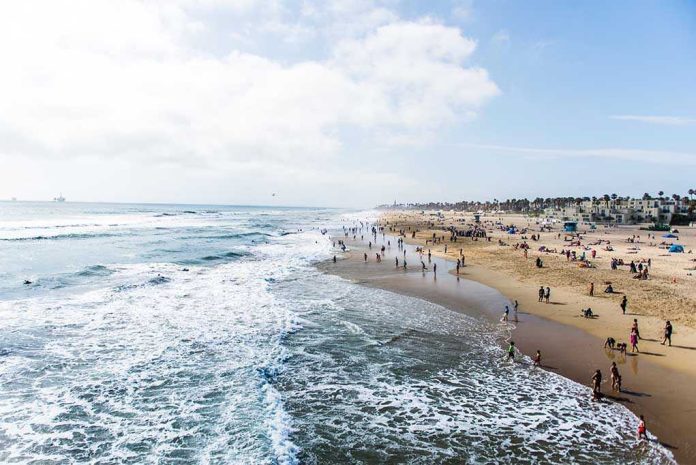
Imagine a day at the beach ending with a sudden heart-pounding struggle against nature’s stealthiest danger—rip currents.
At a Glance
- Rip currents appear deceptively calm but are a leading cause of beach rescues and drownings.
- These fast-moving channels of water can occur on any beach with breaking waves.
- Public education and real-time monitoring are crucial for effective mitigation.
- Despite technological advancements, public compliance with safety advisories is still a challenge.
Understanding the Rip Current Menace
Rip currents, often mistaken for the serene stretches of water between breaking waves, are powerful, narrow channels of fast-moving water that pull swimmers away from the shore. They are not caused by tides but by interactions between waves and the shoreline. When wind and breaking waves push water towards the shore, it increases the water level. This excess water finds its way back to the sea, creating a rip current, often through a break in a sandbar or near man-made structures like piers.
Rip currents can occur on any beach with breaking waves, including oceans, seas, and large lakes. On the surface, they may appear as calm, darker patches of water, misleading swimmers into entering these dangerous zones. Despite their subtle appearance, rip currents are a leading cause of lifeguard rescues and drowning incidents worldwide, especially during high surf events or busy holiday weekends.
Who Bears the Brunt?
Beachgoers and swimmers are the primary at-risk group, often unaware of the dangers or how to escape a rip current. Lifeguards and first responders are crucial in monitoring, warning, and rescuing individuals caught in these currents. Their role extends beyond rescue to public education, often being the first line of defense on beaches.
The National Weather Service (NWS) and NOAA provide forecasts, warnings, and educational resources to help beach authorities implement safety measures. Coastal scientists and oceanographers study rip current formation and behavior, influencing policy and safety recommendations. Meanwhile, the tourism industry is invested in ensuring beach safety to protect visitors and maintain the reputation of coastal destinations.
Current Developments and Safety Measures
Advancements in oceanography and coastal engineering have improved rip current detection and forecasting. Researchers are using remote sensing, drones, and advanced modeling to improve real-time detection. Public awareness campaigns like “Break the Grip of the Rip” aim to educate beachgoers on identifying and escaping rip currents. Some beaches have implemented color-coded flag systems and digital signage to indicate current rip current risk levels.
Despite these efforts, rip currents remain a persistent hazard, with hundreds of fatalities and thousands of rescues annually in the United States alone. Technological advancements are improving detection, but challenges remain in public compliance and understanding. Lifeguard organizations emphasize the importance of swimming near staffed lifeguard towers and heeding posted warnings.
The Ripple Effect: Impacts and Solutions
The immediate risk posed by rip currents leads to rescues, injuries, and fatalities, placing a strain on lifeguard and emergency response resources. Long-term implications include the ongoing need for public education and infrastructure investment to reduce incidents. Coastal communities reliant on tourism are particularly impacted by rip current incidents, both in terms of public safety and economic consequences.
Experts agree that a combination of scientific research, public education, real-time monitoring, and robust lifeguard presence is essential for effective mitigation. While technological solutions like real-time detection are being explored, behavioral interventions such as education and signage are also crucial. The debate continues over the most effective communication strategies for reaching at-risk populations, including tourists and non-native speakers.
Sources:
National Weather Service: Rip Current Science
NOAA National Ocean Service: Rip Currents







